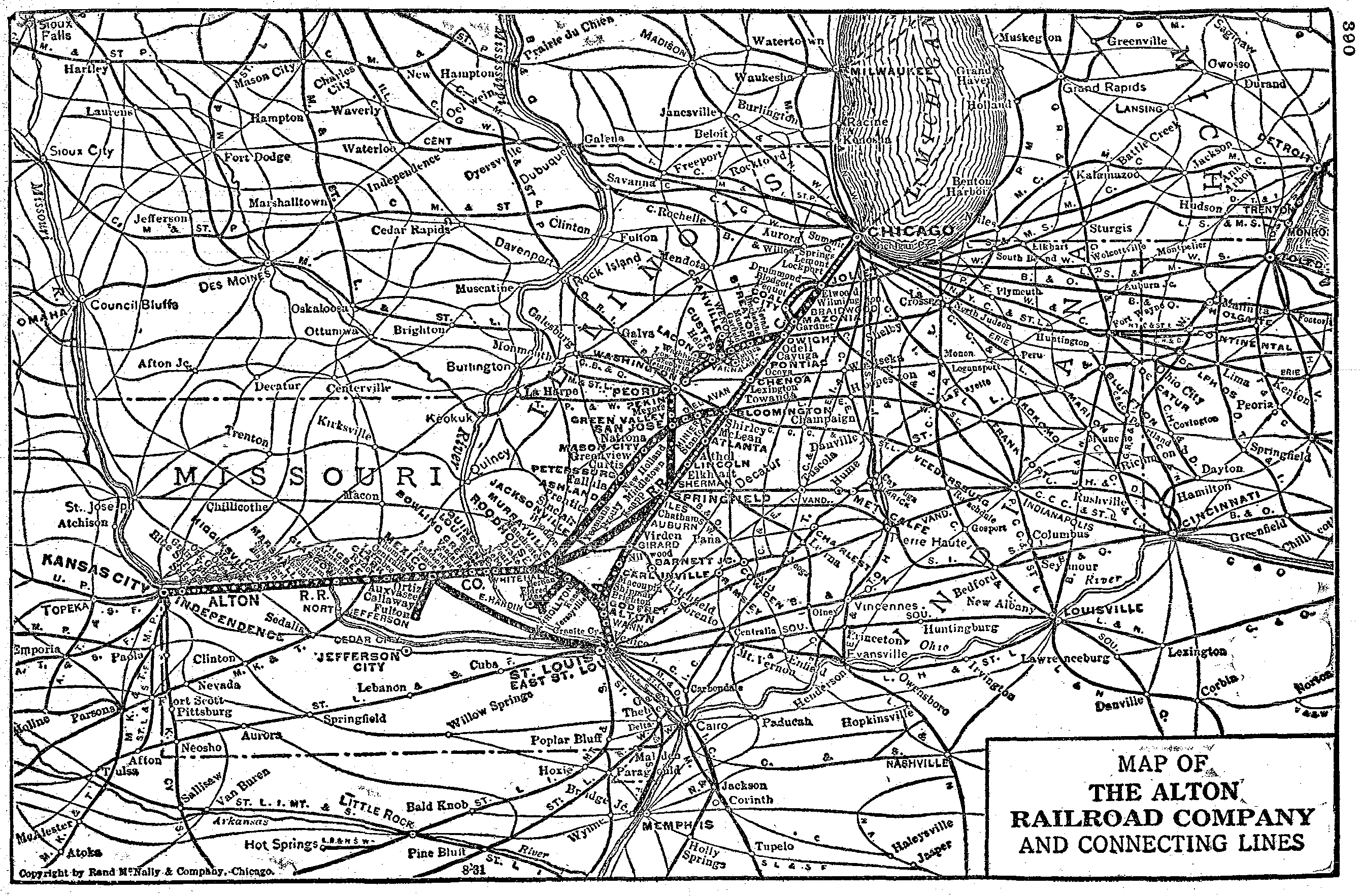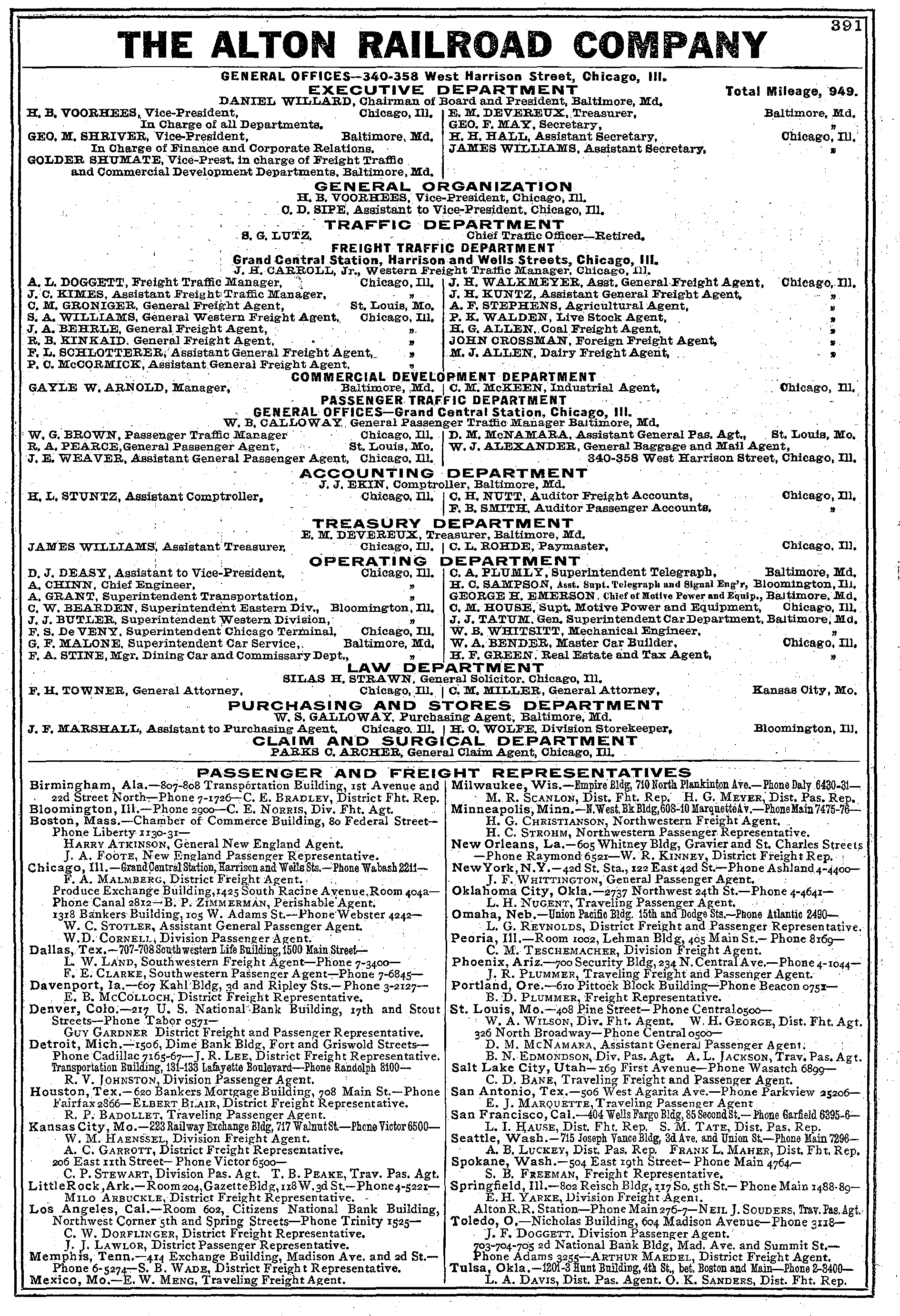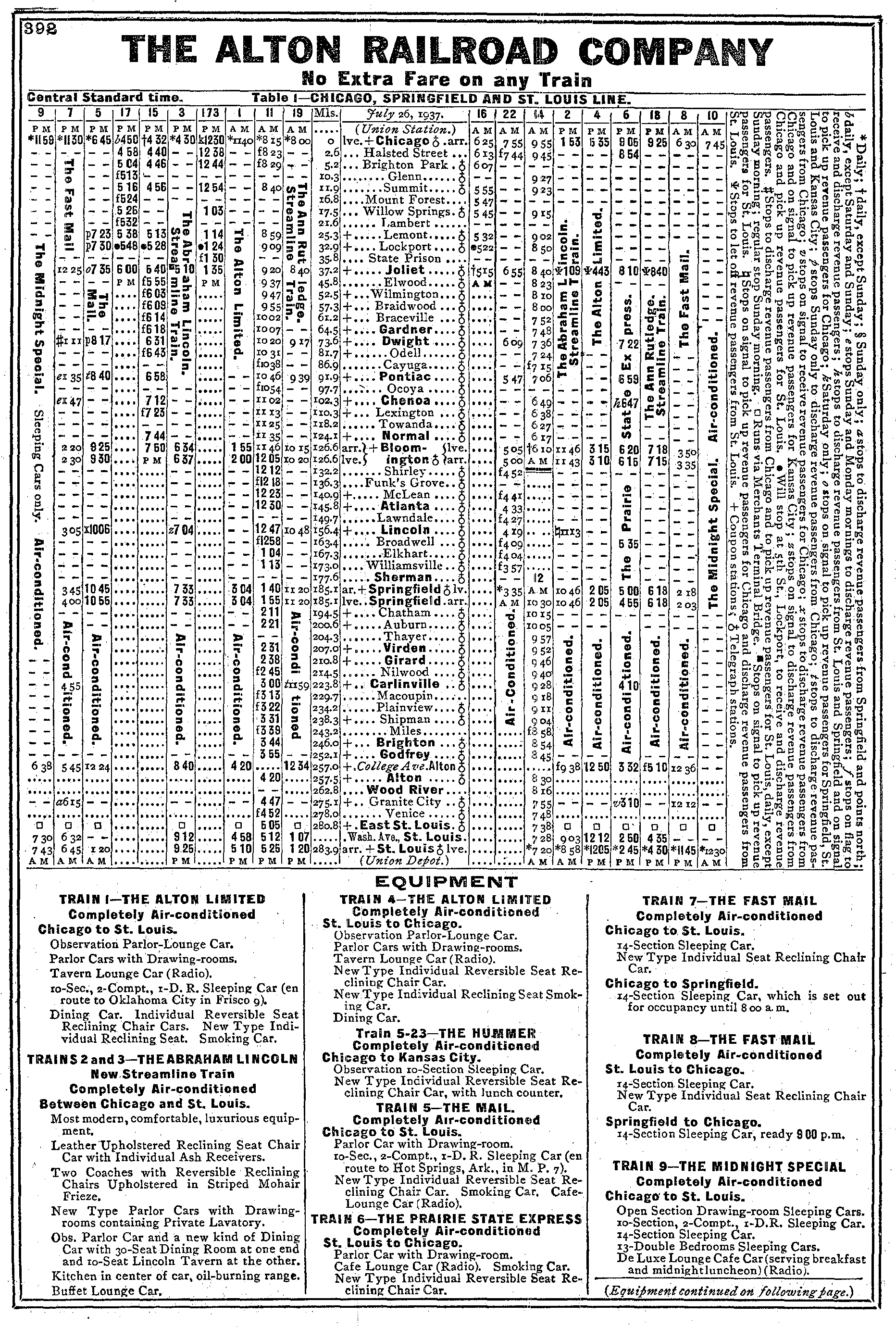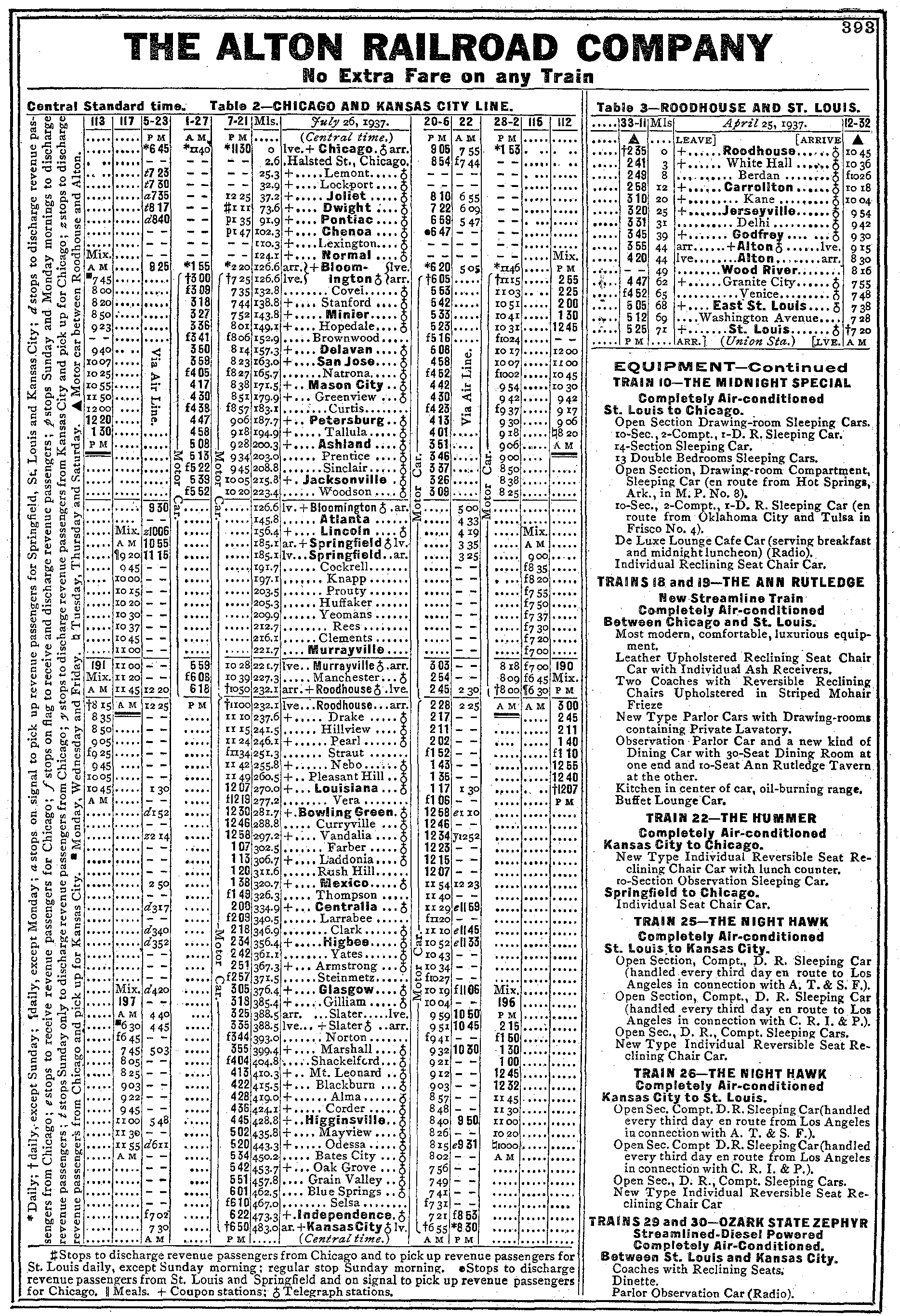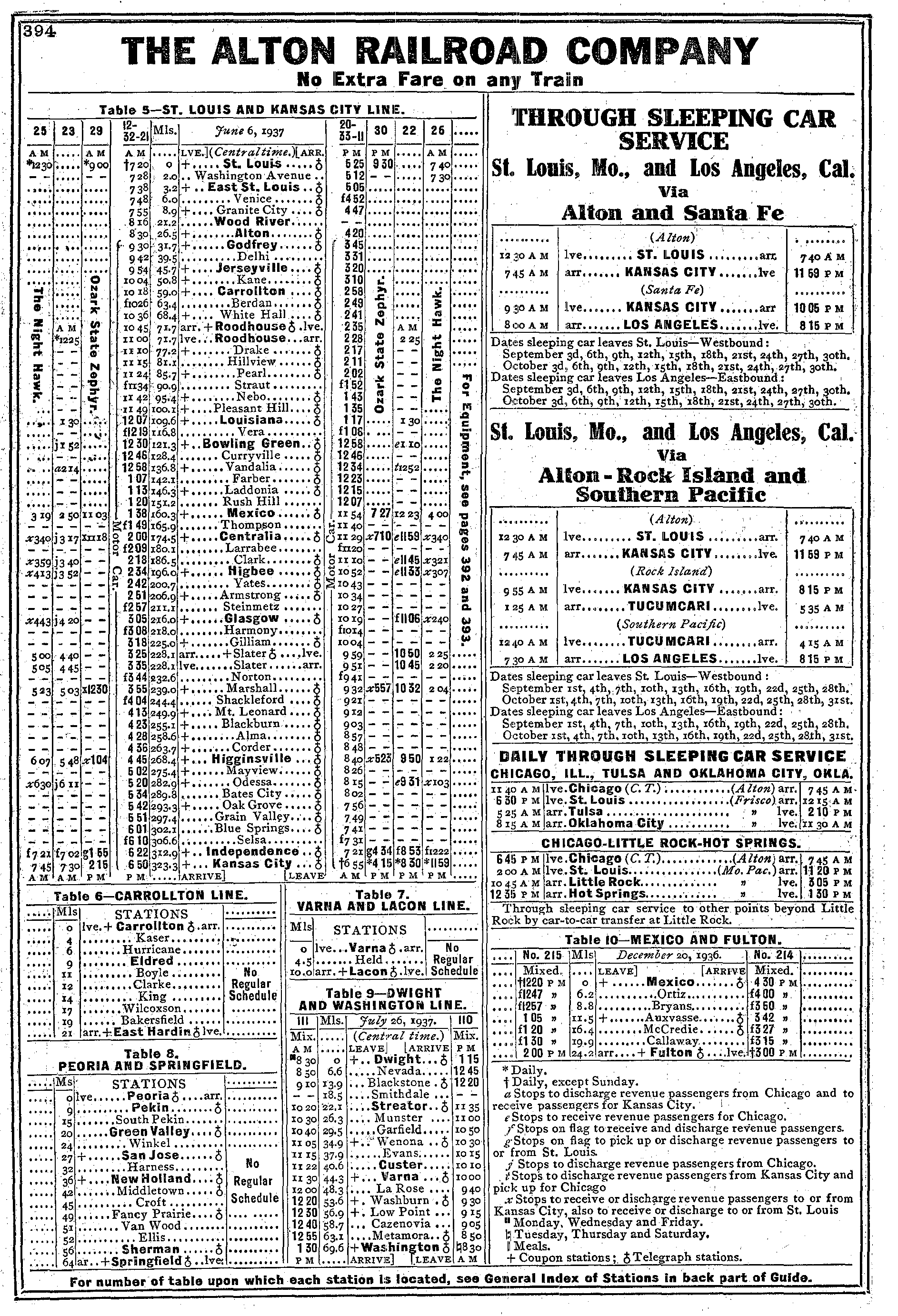Alton Railroad: Map, History, Timetables
Last revised: August 23, 2024
By: Adam Burns
The Alton Railroad was a railroad company based in the United States that operated from 1847 to 1947. It was originally known as the Alton and Sangamon Railroad, serving Illinois.
The railroad underwent several name changes and mergers throughout its existence, including being absorbed by the Chicago and Alton Railroad, and later became part of the Gulf, Mobile and Ohio. It played a significant role in the development of transportation in the Midwest during the 19th and early 20th centuries.
For many years the Alton was known as the Chicago and Alton prior to its 1931 acquisition by the Baltimore and Ohio. The C&A was known for its high-speed service and luxurious passenger cars. Today, components of its network that linked Chicago, St. Louis, and Kansas City remain active.
History
Alton Railroad, formally known as the Chicago and Alton Railroad, holds a significant place in the annals of American railroad history. It was initially built to serve as a crucial transportation link between Alton, Illinois, and Springfield, Illinois.
Its inception can be traced back to April 27, 1847, when it was incorporated under the name Alton and Sangamon Railroad. The primary purpose was to facilitate a seamless flow of passengers and goods across the states it served, spurring economic growth and development.
The Alton Railroad did not evolve in isolation; rather, it had a lineage tracing back to a variety of predecessor railroads. Its evolution began with the Alton and Sangamon Railroad, charted to link Alton, situated along the Mississippi River, with the state capital of Springfield. The line was completed in 1852, by which point it had been reorganized as the Chicago and Mississippi Railroad.
By 1855 the C&M had also reached Joliet and Bloomington. Just a year later it leased the Joliet and Chicago Railroad, provided a direct link into the Windy City. In 1857 the C&M was reorganized as the St. Louis, Alton and Chicago Railroad, and finally as the Chicago & Alton Railroad on October 10, 1862.
The new C&A continued to expand and had reached East St. Louis by 1864 through a subsidiary known as the Alton and St. Louis Railroad. During the C&A's peak, the railroad maintained 1,053 route miles. This spectacular expanse effectively connected communities, fostering mobility, trade, and communication.
Operating primarily in the Midwest, the Alton Railroad stretched its services across Illinois, and Missouri, and Kansas. During its height, it was a dependable conduit for transportation in these states, contributing significantly to their economic and infrastructural development.
Baltimore & Ohio
The Alton Railroad underwent significant changes in the early twentieth century. The Baltimore and Ohio Railroad (B&O), in a bid to extend its reach into the Midwest, acquired the bankrupt C&A in 1929, renaming the property as the Alton Railroad in 1931.
The B&O saw the Alton as a strategic addition to broaden their reach in the Midwest, notably Kansas City. This period, under the B&O's stewardship, was marked by several significant changes, including improvements in operational efficiency and customer service.
Perhaps most notable from the public perspective was the launching of a new streamliner, the "Abraham Lincoln," launched in 1935. In 1937 it was joined by the "Ann Rutledge." Both trainsets, featuring equipment from American Car & Foundry and new diesels like the #50 boxcab and streamlined EA from Electro-Motive, dazzled the public.
The addition of the Alton represented one of many examples of the B&O's growth during that era as president Daniel Willard aimed to expand the railroad prodigiously in an effort to improve its competitive standing against the Pennsylvania and New York Central railroads.
The B&O's main objective was to make the Alton a more competitive player in the railroad industry during the challenging economic times of the early twentieth century.
The alliance with the B&O was short-lived, however, as the railroad did not provide the railroad with the hoped-for market gains. As a result, Kirk Reynolds and Dave Oroszi note in their book, the "Baltimore & Ohio Railroad," the Alton's was separated from B&O in 1942 under a new company but the carrier remained in control of the system.
Finally, it was allowed to slip into receivership and acquired by the Gulf, Mobile & Ohio in May, 1947. As Alton Railroad transitioned into the new setup under the Gulf, Mobile and Ohio, it retained its iconic routes, such as the Lincoln service between Chicago and St. Louis. This continuity in service ensured that the legacy of the Alton Railroad was kept alive, even as its identity transitioned.
The emphasis on economic growth and development was a driving agenda behind the establishment of the Alton Railroad. In essence, it was crafted to be an artery of commerce, ensuring goods, people, and resources flowed unimpeded across the states it served.
The Alton Railroad held a crucial role in the agricultural sector. By providing reliable transport links, it significantly contributed to the movement of agricultural goods, impacting the farming industry in the regions it served.
System Map (1937)
Furthermore, the Alton also had an impact on the urbanization trends in the regions it served. Cities along the route experienced growth and expansion, attributable partly to the connectivity the railroad provided.
In terms of infrastructure, the Alton was recognized for its grand Union Station in Chicago, shared with the Pennsylvania Railroad. This architectural landmark serves as a poignant reminder of the Alton Railroad's historical significance. Other roads to use this terminal included the Milwaukee Road and Chicago, Burlington & Quincy.
Fast-forward to the present day, railroads that once formed part of the Alton Railroad are operated by Amtrak and Union Pacific, affirming its enduring legacy. This legacy speaks volumes of the Alton Railroad's significance in the story of America's railroad industry.
In conclusion, dissecting the complex genealogy of the Alton Railroad provides insights into the evolution of America’s railroad industry. Its existence illustrates the cycles of expansion, consolidation, and adaptability that have shaped the railroad networks we see today.
Timetables (1937)
Legacy
While much of its physical infrastructure may no longer exist, the memories of the Alton Railroad persist. Tales of its impeccable passenger service, spectacular routes, punctuality, and contribution to regional development continue to echo through the annals of American railroad history.
Moreover, the impact the Alton had on shaping the region's economy and infrastructure serves as a testament to its historic relevance. Cities that have grown along its tracks owe part of their development to the resources and connectivity that the railroad provided.
Its merger with the Gulf, Mobile and Ohio underlines its corporate journey’s pinnacle, integrating into a vast network of tracks that spanned the vast American landscape. The Alton's tale affirms the transformative power of railroads in shaping America's economic and geographical landscape.
Coupled with its subsequent acquisition by the Baltimore and Ohio and final merger into the Gulf, Mobile and Ohio, the Alton Railroad's story is a testament to the dynamism and consolidation characteristic of the American railway industry in the twentieth century.
The Alton Railroad is not just a defunct railroad company; it is a historic artifact that offers valuable insights into America’s socio-economic development during the nineteenth and twentieth centuries. Its story weaves into the story of America itself, shaping and being shaped by the country's growth over the centuries.
In studying the Alton Railroad, we gain a richer understanding of the country's broader railway network's trajectory - its consolidation, expansion, and adaptation to the tides of change. The Alton Railroad stands as a testament to America's reliance on railroads as a tool for growth and connectivity.
Today, while the original Alton Railroad may not exist under the same name, its tracks continue to support thriving rail traffic, contributing to the economy and the mobility of the region. This ongoing contribution reinforces the enduring essence of the Alton Railroad.
Its enduring legacy underscores the intrinsic role railroads play in supporting national growth. From fostering economic development to facilitating urban expansion, the Alton Railroad's contributions underline the power of railroads as catalysts of transformation.
In the end, the Alton Railroad's history is a reflection of American railroad history and America's expanding frontiers. It is an epic tale of tenacity, resilience, adaptability and commitment to economic growth and progress.
Thus, the Chicago and Alton Railroad, better known as the Alton Railroad, is far more than a story of a transportation company. It is a living testament to the power of railroads as a tool for economic expansion and societal development, an integral part of the rich tapestry of America’s history.
Sources
- Reynolds, Kirk and Oroszi, David. Baltimore & Ohio Railroad. Osceola: MBI Publishing, 2000.
- Schafer, Mike. Classic American Railroads. Osceola: MBI Publishing, 1996.
- Schafer, Mike. More Classic American Railroads. Osceola: MBI Publishing, 2000.
Recent Articles
-
Oregon Railroad Museums: A Complete Guide
Apr 25, 25 03:11 PM
With its rich tapestry of scenic landscapes and profound historical significance, Oregon possesses several railroad museums that offer insights into the state’s transportation heritage. -
North Carolina Railroad Museums: A Complete Guide
Apr 25, 25 02:56 PM
Today, several museums in North Caorlina preserve its illustrious past, offering visitors a glimpse into the world of railroads with artifacts, model trains, and historic locomotives. -
New Jersey Railroad Museums: A Complete Guide
Apr 25, 25 11:48 AM
New Jersey offers a fascinating glimpse into its railroad legacy through its well-preserved museums found throughout the state.
